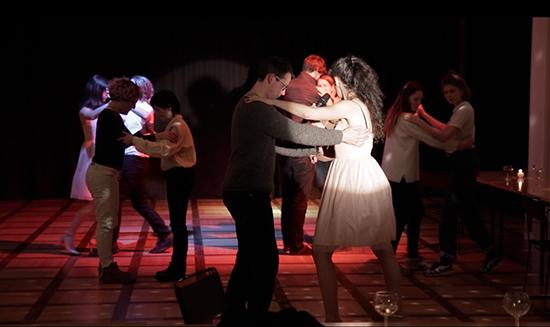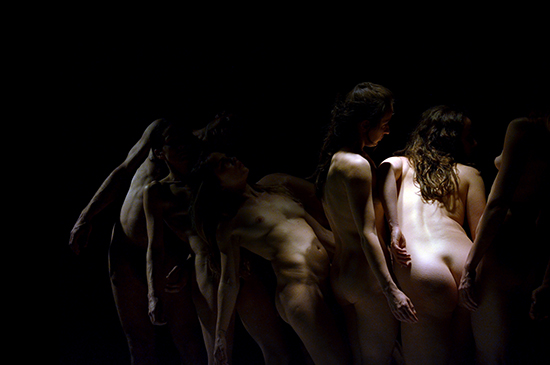From Europe: Two kinds of nakedness
Jana Perkovic: Perforations Festival, Croatia

Market of Love, Dragana Bulut
“We know that art is not a matter of taste. We believe there should be more than one chance. We think working conditions can always be better. We experienced that, if there is a problem, it is usually with the system.”
This is the manifesto of Perforations, a festival of small, intimate, politically charged works from the Balkans. Over almost a decade, Perforations has grown and shrunk geographically, with seasons presented as far afield as New York and with artists coming from as far as Bulgaria and Macedonia. At its core, though, are independent performance makers from Croatia. Widely considered one of Europe's best small theatre festivals, it is astutely curated by Zvonimir Dobrovic to emphasise the intersection of individual and collective identity: political, social, sexual or gender. This year, two works left an impression.
Speed-dating as art: Dragana Bulut's Market of Love
Berlin-based Serbian choreographer and dancer Dragana Bulut was inspired by her family's concerns about her status as a single woman to devise Market of Love, a performance based on the structure of speed-dating. The show—which comes with free wine and runs until very late—initially simply consists of 10-minute speed dates with other audience members. Halfway through, Bulut, who participates in the dating, stops the proceedings to introduce written scripts that she forces upon participants. Then speeches, long dialogues, film scenes and dances gradually emerge; a series of romance clichés and popular culture offcuts.
The audience was mostly a select, interconnected group of artists and friends, but this precisely lent poignancy to the work. In the preliminary assessment interview—of what, one wonders: attractiveness, goodness, long-term compatibility?—the mating ritual of dating is distanciated and made strange by conducting it on friends, friends of friends, straight and queer, partnered and single. The fatigue of choice, of decision-making, sets in quickly. Participants are gradually revealed to be performers: wonderfully enacted scripts of love, longing and reticence emerge in this community of daters. And yet, interestingly, many performers—quick to join in the scripted dialogues—are revealed to be general audience members. They simply remember that film, that song. What emerges in Market of Love is a surprising understanding of just how scripted our gestures of love are, a source text we all know by heart.
I found myself accidentally speed-dating highly respected artist, theorist and pedagogue Goran Sergej Pristaš, co-founder of BADCo performance collective. It is to Bulut's credit that we ended the night dancing together, though he claimed not to be a good dancer. Ultimately it did not matter: alongside its surface cynicism and pop-cultural critique, Market of Love maintained a levity and joyousness.

Denuded, Bruno Isakovic
Evocative nudity: Bruno Isakovic's Necastive
Necastive (Denuded) is something else entirely. Choreographer Bruno Isakovic commenced it as a solo project [which was seen in Hobart at the Salamanca Arts Centre in February this year. Eds], a formal exploration of the relationship between breathing and physical tension. At Perforations, the work had grown to 11 performers, all dancers, all performing nude. Not having seen other versions, I found Denuded flawless, and unimaginable in any other version. Whereas a solo piece would have emphasised the texture of the body—its breathing rhythm and moving rhythm, the space it demarcates and centres—the mass of bodies, of different sexes, ages and training, gives volume to that same texture, but adds tension, emotion, narrative and the unavoidable weight of visual references. The most remarkable choreography I have seen in years, Denuded is rigorous in concept and execution, yet immensely open to interpretation.
It opens simply, with 11 bodies standing still, breathing. With a slowness that makes changes in posture at first imperceptible, the performers start sliding into a series of tableaux. A lot occurs behind this simple description. The shifting images resonate with one's own visual library, activating memories of iconic paintings, yet somehow reduced to their cultural archetypes. The sharp lighting accentuates anatomy. There is Michelangelo in here, as well as Caravaggio. There are final judgements, falling angels, hells and heavens; there are bodies walking to their execution; and bodies blown away by natural or spiritual calamities. There are gardens of Eden, languidly erotic afternoons, mourning mothers of Christ; there is grief and salvation.
It is all so slow, so focused, yet one gradually becomes finely attuned to the rhythm of the performance, noticing that the tension is not flat, but ebbs and flows with an organic unpredictability. For a long time, the performers keep in uncomfortable balance, one foot always slightly lifted, torso always slightly contorted. It breaks, though: sometimes bodies collapse like dominoes, pulling each other apart with the slow inevitability of an avalanche or crumbling iceberg. At other times, a performer will simply change posture, or begin a series of movements that reverbrate through other bodies. Performers may all lean onto one another, hold, drop, break off. Somewhere along the line, you realise that breathing is the soundtrack to the work: the exaggerated, deep breathing of the performers. Like deep bass, it dictates the quality of the movement. And like deep bass, the audience can feel it viscerally: 11 deep breathers make one hell of a sound.
Necastive begins macabre and tense; it ends joyous and relaxed. Images of bodies flung by great forces, holding onto each other as if for dear life, transform into images of salvation, celebration and relaxation. It is simultaneously profane and profoundly religious, like the paintings it references. The uneasy relationship that Christianity has with the body—something to control, but never ignore—is constantly on one's mind.
And finally, in the very last minutes of performance, when the bodies break into laughter (a radical shift in breathing) and a comparatively unbound movement of rolls and skips, it is a momentous gesture of freedom. Of humanism.
See Bruno Isakovic speak about Necastive with excerpts from the performance below:
Bruno Isakovic / Denuded (world premiere) from Be SpecACTive! on Vimeo.
Perforations Festival: Market of Love, author Dragana Bulut, performers Dragana Bulut, Zeina Hana, Chris Scherer, Cinema foyer SC, Zagreb, 17 June; Necastive (Denuded), choreographer Bruno Isakovic, 10 June, HKD Teaterm, Rijeka; Perforations Festival, Croatia: in Zagreb, Rijeka, Split, Dubrovnik, 10-28 June
RealTime issue #133 June-July 2016 pg.






